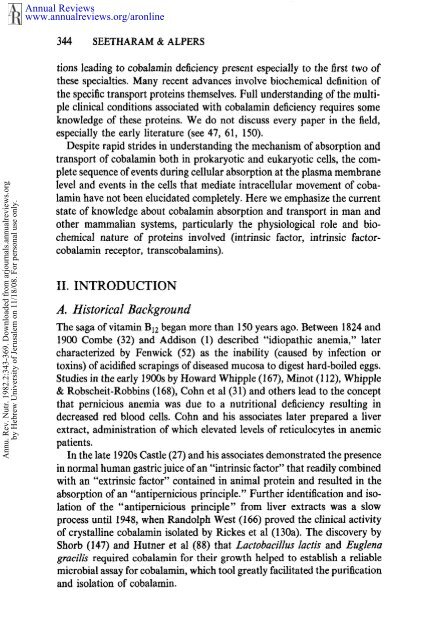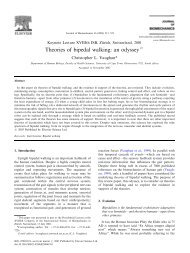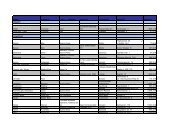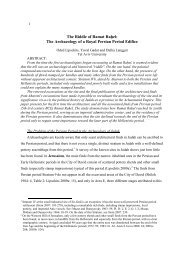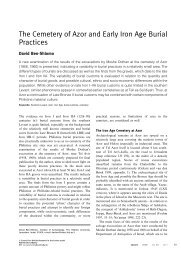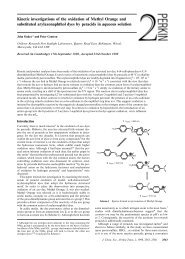Absorption and Transport of Cobalamin (Vitamin B12)
Absorption and Transport of Cobalamin (Vitamin B12)
Absorption and Transport of Cobalamin (Vitamin B12)
Create successful ePaper yourself
Turn your PDF publications into a flip-book with our unique Google optimized e-Paper software.
Annual Reviewswww.annualreviews.org/aronline344 SEETHARAM & ALPERSAnnu. Rev. Nutr. 1982.2:343-369. Downloaded from arjournals.annualreviews.orgby Hebrew University <strong>of</strong> Jerusalem on 11/18/08. For personal use only.tions leading to cobalamin deficiency present especially to the first two <strong>of</strong>these specialties. Many recent advances involve biochemical definition <strong>of</strong>the specific transport proteins themselves. Full underst<strong>and</strong>ing <strong>of</strong> the multipleclinical conditions associated with cobalamin deficiency requires someknowledge <strong>of</strong> these proteins. We do not discuss every paper in the field,especially the early literature (see 47, 61, 150).Despite rapid strides in underst<strong>and</strong>ing the mechanism <strong>of</strong> absorption <strong>and</strong>transport <strong>of</strong> cobalamin both in prokaryotic <strong>and</strong> eukaryotic cells, the completesequence <strong>of</strong> events during cellular absorption at the plasma membranelevel <strong>and</strong> events in the ceils that mediate intracellular movement <strong>of</strong> cobalaminhave not been elucidated completely. Here we emphasize the currentstate <strong>of</strong> knowledge about cobalamin absorption <strong>and</strong> transport in man <strong>and</strong>other mammalian systems, particularly the physiological role <strong>and</strong> biochemicalnature <strong>of</strong> proteins involved (intrinsic factor, intrinsic factorcobalaminreceptor, transcobalamins).II.INTRODUCTIONA. Historical BackgroundThe saga <strong>of</strong> vitamin <strong>B12</strong> began more than 150 years ago. Between 1824 <strong>and</strong>1900 Combe (32) <strong>and</strong> Addison (1) described "idiopathic anemia," latercharacterized by Fenwick (52) as the inability (caused by infectiontoxins) <strong>of</strong> acidified scrapings <strong>of</strong> diseased mucosa to digest hard-boiled eggs.Studies in the early 1900s by Howard Whipple (167), Minot (112), Whipple& Robscheit-Robbins (168), Cohn et al (31) <strong>and</strong> others lead to the conceptthat pernicious anemia was due to a nutritional deficiency resulting indecreased red blood cells. Cohn <strong>and</strong> his associates later prepared a liverextract, administration <strong>of</strong> which elevated levels <strong>of</strong> reticulocytes in anemicpatients.In the late 1920s Castle (27) <strong>and</strong> his associates demonstrated the presencein normal human gastric juice <strong>of</strong> an "intrinsic factor" that readily combinedwith an "extrinsic factor" contained in animal protein <strong>and</strong> resulted in theabsorption <strong>of</strong> an "antipernicious principle." Further identification <strong>and</strong> isolation<strong>of</strong> the "antipernicious principle" from liver extracts was a slowprocess until 1948, when R<strong>and</strong>olph West (166) proved the clinical activity<strong>of</strong> crystalline cobalamin isolated by Rickes et al (130a). The discoveryShorb (147) <strong>and</strong> Hutner et al (88) that Lactobacillus lactis <strong>and</strong> Euglenagracilis required cobalamin for their growth helped to establish a reliablemicrobial assay for cobalamin, which tool greatly facilitated the purification<strong>and</strong> isolation <strong>of</strong> cobalamin.


